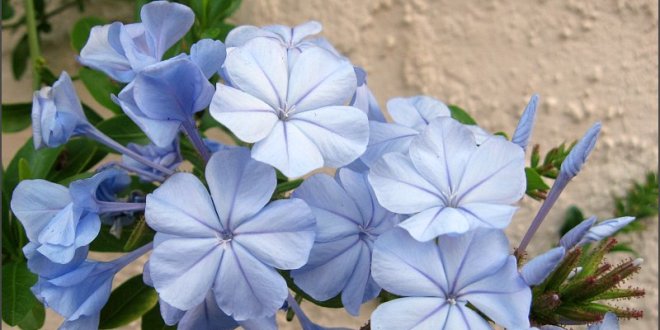Plumbago can be grown as a bush or a climber-vine. You don’t need much room – I was able to plant it in a 3-inch trench next to a wall. Every winter I cut it back to two feet high. Every year it needs several prunings to keep it from overtopping the 8-foot walls in my Sunnyvale garden.
The generic name, derived from the Latin words plumbum (“lead”) and agere (“to resemble”), was first used by Pliny the Elder (23-79) for a plant known as μολύβδαινα (molybdaina) to Pedanius Dioscorides (ca. 40-90).[This may have referred to its lead-blue flower colour[citation needed], the ability of the sap to create lead-colored stains on skin, or Pliny’s belief that the plant was a cure for lead poisoning (for example: plumbing equals lead pipes).
Plumbago auriculata is an evergreen shrub, often grown as a climber, ascending rapidly to 6 m (20 ft) tall by 3 m (10 ft) wide in nature, though much smaller when cultivated as a houseplant. The leaves are a glossy green and grow to 5 cm (2 in) long. The stems are long, thin, and climbing. The leaves alternate and are 2-5 cm while the five petals are about 2 cm wide and can be pale blue, blue or violet in color. There also variations with white (P. auriculata var. alba) or deep blue (P. auriculata ‘Royal Cape’) flowers. The flowers are arranged in a corymb-like and raceme inflorescence.[7] The flower of this plant is complete and perfect. The sepals and petals are connate while the pistil is adnate. The ovary of the flower is superior and the flower has regular symmetry. It has basal placentation, with 1 locule and 5 carpels.
Details
Family: Plumbaginaceae (plum-baj-i-NAY-see-ee) (Info)
Genus: Plumbago (plum-BAY-go) (Info)
Species: auriculata (aw-rik-yoo-LAY-tuh) (Info)
Synonym:Plumbago capensis
Category:
Shrubs Tropicals and Tender Perennials
Height: 3 to 10 feet
Spacing:2 – 4 feet
Hardiness:
USDA Zone 8a: to -12.2 °C (10 °F)
USDA Zone 8b: to -9.4 °C (15 °F)
USDA Zone 9a: to -6.6 °C (20 °F)
USDA Zone 9b: to -3.8 °C (25 °F)
USDA Zone 10a: to -1.1 °C (30 °F)
USDA Zone 10b: to 1.7 °C (35 °F)
USDA Zone 11: above 4.5 °C (40 °F)
Sun Exposure: Sun to Partial Shade
Danger: All parts of plant are poisonous if ingested
Bloom Color: Light Blue
Bloom Time: Blooms repeatedly
Foliage: Evergreen
Other details: Drought-tolerant; suitable for xeriscaping. This plant is resistant to deer
Soil pH requirements: 6.1 to 6.5 (mildly acidic)
Patent Information: Non-patented
Propagation Methods: By dividing the rootball. From semi-hardwood cuttings
Seed Collecting: Unknown – Tell us
Read more: http://davesgarden.com/guides/pf/go/414/#ixzz3HUgsI0Gc








